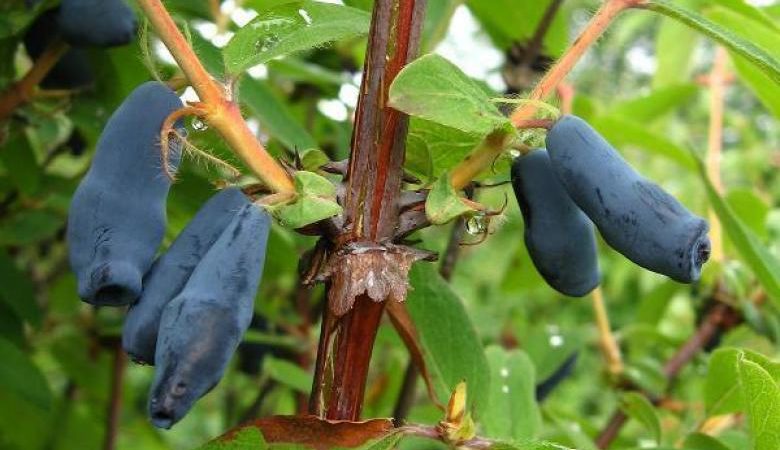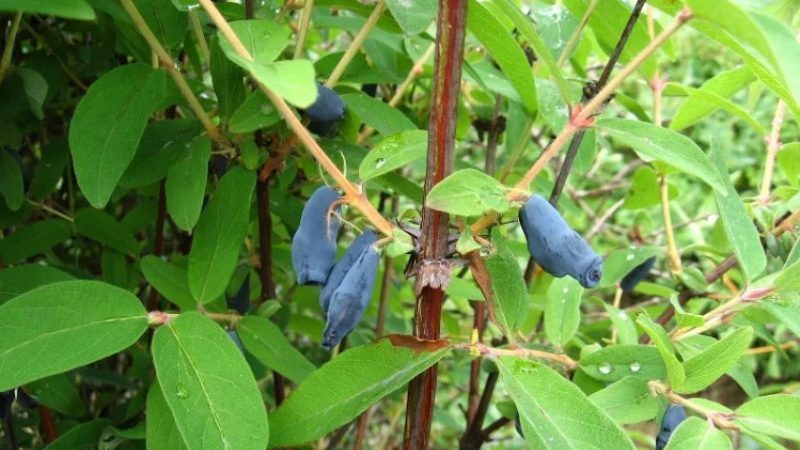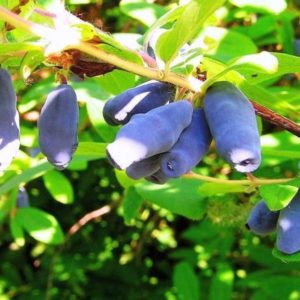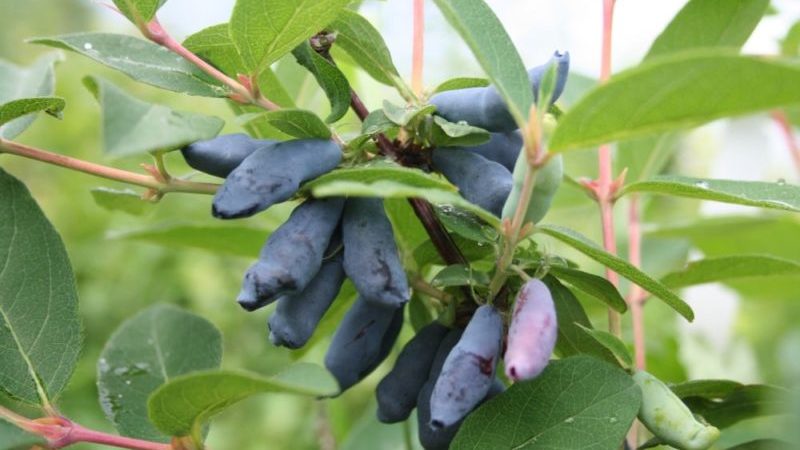Mid-season honeysuckle with sweet and sour taste "Nightingale"
Increasingly, edible honeysuckle bushes can be found in garden plots. One of the most popular varieties is the Nightingale, famous for its excellent taste and high content of vitamin C. It is easy to care for it - you just need to follow simple rules of agricultural technology. In the article we will give a detailed description of the Nightingale honeysuckle, talk about the nuances of care and possible difficulties in growing.
The content of the article
Description of the variety of honeysuckle Nightingale
Nightingale is a mid-season popular edible honeysuckle variety that is also planted for decorative purposes.

Origin and development, history of breeding
The nightingale was obtained by crossing a seaside variety with Pavlovskaya honeysuckle. The breeders of the Pavlovsk experimental station, located in the Leningrad region, were engaged in breeding.
In 2002, the Nightingale was entered in the State Register of Russia, but now it is popular in other countries of the world with suitable climatic conditions.
Description of appearance, taste
Nightingale bushes grow up to 1.3 m, dense, with a squat, reverse conical crown. Shoots are thin, pubescent. Leaves are green, dense, elongated oval in shape. The berries have a bumpy surface, outwardly resemble a spindle, with a pronounced saucer at the top. The mass of berries is small - up to 1 g. Under the dense skin hides a delicate pulp with a sweet and sour taste.
Reference. Tasting assessment of fruits - 4.6 points out of 5. The berries have a low calorie content - 42 kcal per 100 g.
Features of the use of this variety
Honeysuckle Nightingale is an edible variety suitable for dessert use and fruit processing (compotes, jams, syrups, tinctures).
Productivity and ripening period

From each bush collect from 1.1 to 2.5 kg. In mid-latitudes, the flowering period begins in early May, and the fruits ripen in late June. In the south, the crop is harvested 2-3 weeks earlier. In the northern regions, the fruits are picked in mid to late July.
Resistance to diseases and pests, cold and drought
The variety has a stable immunity to most diseases and pests.
The nightingale has good frost resistance, withstanding cold temperatures down to -45 ° C. But this honeysuckle does not like drought, due to a lack of moisture, the berries become bitter.
For which regions it is best suited and what is the exacting climate
The variety grows well in most regions of the country, with the exception of places where the temperature drops below -45 ° C in winter. Honeysuckle is also grown in arid areas, subject to watering rules. The Nightingale shows the best results in central Russia.
The main advantages and disadvantages of the variety
The positive qualities of the variety include:
- strong immunity;

- frost resistance;
- good fruit taste;
- universality of application;
- resistance to sudden temperature surges;
- non-sprinkling of berries;
- unpretentious care;
- good yield;
- decorativeness.
Disadvantages:
- moisture deficiency affects the taste of berries;
- self-infertility, which is why third-party pollinators are necessarily planted nearby.
What is the difference from other varieties and hybrids
The nightingale is not prone to shedding after maturation. Fruits last about 7-10 days after maturity.
Agrotechnics
Honeysuckle Nightingale does not require much effort when planting and caring.
Choosing a place in the garden and preparing holes
For planting seedlings of this variety, a well-lit area is selected. It is important to protect the planting from strong winds and drafts. The soil needs to be well moistened, but without stagnant water - this will cause the root system of the seedling to rot.
It is preferable to plant honeysuckle in the area where potatoes, legumes, carrots, pumpkin were previously grown.
The holes are prepared with a diameter of 0.8 m and a depth of 0.4 m.The distance between them is kept at least 1.5 m.
Preparing for landing
Before planting, seedlings are carefully examined for mechanical damage or traces of disease. The optimum age of the seedling is 2 years. He must have a strong root system and several large shoots.
Ground requirements
Loose, sandy loam and loamy soils with a neutral pH (5-7) are best suited.
Timing, scheme and landing rules
In edible honeysuckle, the process of sap flow is considered early, so the seedlings are placed in the ground in the fall, in late September - early October. In this case, the seedling will quickly take root and begin to grow actively in the spring.
Procedure:
- A small amount of the topsoil mixed with humus in a 1: 1 ratio is poured onto the bottom of the prepared holes. Add 2 tbsp. l. potassium sulfate, 2 tbsp. l. superphosphate and 1 tbsp. wood ash.
- Small mounds are built from the resulting soil mixture.
- The roots of the seedlings are spread on them, the remaining soil is poured on top.
- The soil is lightly crushed and watered - one bucket for each bush.
Growing features
So that moisture does not evaporate too quickly, the soil around the seedlings after planting is mulched with sawdust, dry humus or crushed peat.
The fertilizers used at the very beginning will last for 2 seasons... The next procedure is carried out in the third year. If this is done ahead of time, the bushes will go into active growth, and they will give little fruit.
Since the planting is carried out in the fall, the soil is covered with fallen leaves. In regions with strong cold winds, the branches are covered with burlap without pinching them.
The nuances of care
Water the honeysuckle, preventing the soil from completely drying out, 2 times a week - 1 bucket of water. If the summer is rainy, then watering is reduced to 2-3 times a month.
Fertilizers are applied in the third year. Use humus (10 kg for each bush), ammonium nitrate (15 g per square meter) or urea solution (1 tablespoon per bucket of water).
The first 2-3 years spend only the spring sanitary pruningremoving damaged dry shoots. In the future, every autumn, a forming pruning is done, designed to thin out the dense crown. Remove stems growing from the soil, or too short, weak.
Pollinators
Gardeners recommend planting next to the Nightingale for pollination the following varieties of honeysuckle:
- Morena;
- Blue birdsy;
- Start;
- Malvina;
- Blue spindle.
Disease and pest control
The nightingale is famous for its strong immunity, but if the rules of care are violated or in a rainy and cold summer, the resistance of the variety to diseases and pests decreases.
Insects are dangerous:
- sawflies honeysuckle striped and choppy;
- gall midge, leafy honeysuckle;
- biennial leaf roll.
Insects destroy foliage and fruits, feed on plant juices. Insecticides "Fufanon", "Inta-Vir", "Aktellik", "Kemifos" or "Kinmiks" will help to cope with pests.
Common diseases:
- Brown spotting. Leaves fall off due to the formation of necrotic spots. The fungus is treated with 1% Bordeaux liquid or preparations "HOM" and "Abiga-Peak".
- Powdery mildew. Due to white bloom, foliage crumbles and frost resistance decreases. The drugs Chistotsvet and Tiovit Jet are used.
- Light gray spotted honeysuckle... It affects foliage, it is treated in the same way as brown spot.
Preparing for winter
Adult plants do not cover for the winter, since they easily tolerate frosts down to -45 ° C. Young seedlings need protection, so the soil around the bushes is covered with dry foliage up to 0.5 m thick. At the end of autumn, the shrub is fed with any potassium fertilizer to enhance immunity.
Reproduction
The variety is propagated in several ways:
- By cuttings. Several shoots are cut from the bush, on which at least 2 buds are formed. They are rooted in a suitable container, watered regularly and kept in a well-lit area. After the roots and a few small shoots appear, the cuttings can be moved to open ground.
- By dividing the bush... An adult bush is dug up, divided into several parts and seated in the holes.
- Seeds. It is a long process, so it is rarely used. Such bushes give a crop only for 4 years.
Harvesting
The berries do not ripen at the same time, first the upper fruits ripen, moving into the depths of the bush, and then going down.
How and when to collect
Harvest in June. Do this gradually or after waiting a while until the fruits ripen on the whole bush. At room temperature, the fruits will lie for 4 days, in the refrigerator - 10. The berries tolerate transportation well.
What can be the difficulties in growing
Frequent problems:
- Due to the lack of moisture, the berries become bitter.
- With an excess of fertilizer, the bushes grow well, but yield decreases.
- Honeysuckle Nightingale is self-fertile, so it is better to plant several different varieties so that pollination takes place on time and many ovaries form.
Tips and reviews of experienced gardeners about the variety

General impressions of the Nightingale variety are positive.
Elena Smirnova, Leningrad region: “Nightingale's bushes are beautiful, with lush greenery, but they thicken quickly. I thin them out regularly, then the harvest is richer. The berries are dense, they are stored in the refrigerator for almost 2 weeks. Delicious both fresh and canned. "
Oleg Lopyrev, Krasnodar Territory: “I have been growing the nightingale for 4 years. This is the best variety of honeysuckle. He is not afraid of frost, does not get sick. But you need to water it often, otherwise the berries are rough and bitter. "
Conclusion
The variety of edible honeysuckle Nightingale is considered one of the best. It is easy to care for him, he easily tolerates severe frosts and is not afraid of diseases and pests, and the fruits have excellent taste. It will be possible to grow this plant in almost every corner of Russia.